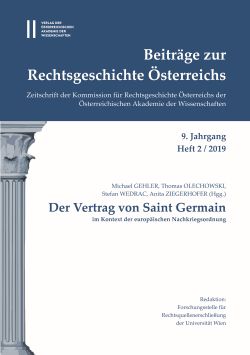
Beiträge zur Rechtsgeschichte Österreichs 9. Jahrgang Heft 2/2019, pp. 362-373, 2019/12/01
Der Vertrag von Saint Germain
im Kontext der europäischen Nachkriegsordnung
The reconstruction of the Polish state after the First World War is commonly associated with the date of 11 November1918. However, this date is primarily symbolic. The process of rebuilding an independent Poland began on an internationalbasis with the publication by the Central Powers of the so-called Act of 5 November 1916. It announced theresurrection of the Kingdom of Poland and started the process of creating the Polish state institutions. The newlycreated Polish Kingdom was not an independent state. The Central States treated the Poles instrumentally and thebest proof of this was their attitude towards Poland during the negotiations with the Ukrainians and the Soviets inBrest Litovsk. On the international stage, Polish sovereignty was de facto guaranteed by the Treaty of Versailles inJune 1919. This Treaty definitely ended the process that had begun with the Act of 5 November 1916. Nevertheless,the Treaty of Versailles did not meet all the expectations of Polish society, especially as far as boundaries were concerned.The peace treaty with the Austrian Republic in Saint Germain in September 1919 went unnoticed in Poland.
Keywords: First World War – Poland – Treaty of Brest-Litovsk – Treaty of St. Germain – Treaty of Versailles